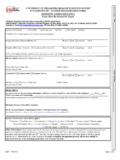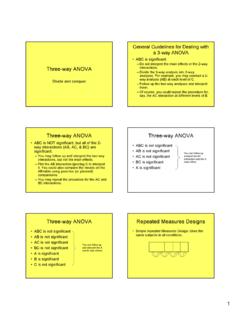Transcription of Art Therapy Techniques: Mask Making Elaine S. Bontempi ...
1 Bontempi 1 Running Head: ART Therapy AND MASKING Making Art Therapy Techniques: Mask Making Elaine S. Bontempi University of Oklahoma Bontempi 2 Art Therapy is a combination of art and psychology applied in a specialized way that uses the power of creative process as a vehicle for healing, communication, self expression, and personal growth. Expressive arts Therapy and art Therapy are two terms that are commonly used interchangeably, but whereas art Therapy includes various techniques including painting, sculpting, collage Making , art journaling, drawing, sand art, mandalas, poetry, music, etc.
2 , expressive arts Therapy is an inter-modal discipline where the therapist and client moves freel between drawing, dancing, music, drama, poetry, etc. The focus of this paper is on art Therapy and a specific technique used within art Therapy : mask Making . In the therapeutic setting, mask Making is an interdisciplinary activity that may incorporate the expressive arts Therapy , or it can be used alone. History of masks masks have been used throughout history for a variety of reasons including religious or cultural ceremonies, healing, or for casting out demonic spirits. In many of the ancient tribal rites the identity of the person wearing the mask was actually transformed into the deity of the mask.
3 masks are the most ancient means of changing identity and assuming a new persona. The very nature of a mask requires an audience of at least one observer, as the wearer transforms his/her identity into that of the mask. masks have also been used in contemporary societies for holidays, festivals, theatrical performances, and social protests. During the Middle Ages in Venice, the wearing of masks became popular as prominent social figures dawned disguises to conceal their identities as they performed unscrupulous and immoral acts in Bontempi 3 pursuit of carnal pleasures. During the 16th through 18th century Venetian masks became the signature of the Commedia Dell'arte.
4 The Commedia Dell'arte were popular plays in the form of improvisational theater that were performed by theater companies that traveled the Italian peninsula producing comedies involving the topics of adultery, jealousy, and love. ( , para 6) In 1797 Venice became part of Austria, and masks were shortly outlawed. Mask Making in Italy was not revived until 1979 when art students resurrected the tradition in order to earn money from tourists. masks in Art Therapy In Therapy , the use of masks can be quite diverse. Designing masks enables clients to project their thoughts into objects that can be viewed as self representative.
5 The goal of mask Making in Therapy is largely personal, and may vary throughout the client s progress in Therapy , and the themes that emerge are often quite varied. masks have been used in individual and group settings to help clients of various ages explore identity and identity formation, to identify and integrate disowned aspects of self, to explore spirituality, to form a deeper connection with a higher power or find a totem, to assume a different or more empowered self, to process an event or emotions and to find balance (Brumleve, 2009; Buchalter, 2009; Ching & Ching, 2006; Malchiodi, 2010; Moon, 2009; and Scott, 2009).
6 The chosen theme of the mask is to be determined within the context of the participant s life and the issues at hand. Bontempi 4 Mask Making is also a popular intervention in art Therapy because it touches upon Jungian concepts, including persona and shadow (Malchiodi, 2010). The term persona comes from the Latin word, meaning "mask," or "false face," as in the mask worn by an actor on a stage. Jung (1981) wrote, One could say, with little exaggeration, that the persona is that which in reality one is not, but which oneself as well as others think one is. In other words, our persona is the appearance we present to the world.
7 It is the character we assume-through it, and how we relate to others. The persona includes our social roles, the kind of clothes we choose to wear, and our individual styles of expressing ourselves. In order to function socially at all, we have to play a part in ways that define our roles (Frager & Fadiman, 2005, para 36). According to Carl Jung, a major task in acquiring self knowledge is understanding the relationship between who one is and how one presents oneself to the world. Adapting to certain occasions, behaving in a manner suitable to that occasion, and knowing how best to navigate a vast multitude of situations is a necessary part of life.
8 For this one needs to develop a healthy persona..the persona serves both as "interface" with the world and protection from the '"outer" world, depending on life experience including how one has been accepted, wounded or rejected when one has naively presented an authentic thought, feeling, or reaction. ( F i tz-Randolph, 2008) Similarly, Boeree (2006) wrote that our persona is, its best, the "good impression we present as we interact with the world on a daily basis. However, it can also be the false impression we use to manipulate people's opinions and behaviors (para Bontempi 5 1). And, at its worst, it can be mistaken (even by ourselves ) for our true nature.
9 In fact, some people have a difficult time differentiating their persona with who they really are. Hopcke (1995) pointed out that as the ego identifies with the persona, people start to believe that they are what they pretend to be. According to Jung, we eventually have to withdraw this identification and learn who we are in the process of individuation. Minority group members and other social outsiders in particular are likely to have problems with their identities because of cultural prejudice and social rejection of their personas. (Frager & Fadiman, 2005, para 38) The shadow, according to Jungian psychology, is the side of our personality that we do not consciously display in public.
10 The shadow contains all the negative tendencies the individual wishes to deny, including our animal instincts, as well as undeveloped positive and negative qualities. According to Jung, the shadow is derived from our pre-human, animal past, when our concerns were limited to survival and reproduction. It is the "dark side" of the ego, and the evil that we are capable of is often stored there. The shadow exists as part of the unconscious mind and is composed of repressed ideas, weaknesses, desires, instincts and shortcomings. It typically represents wildness, chaos and the unknown. The shadow is most dangerous when unrecognized.








